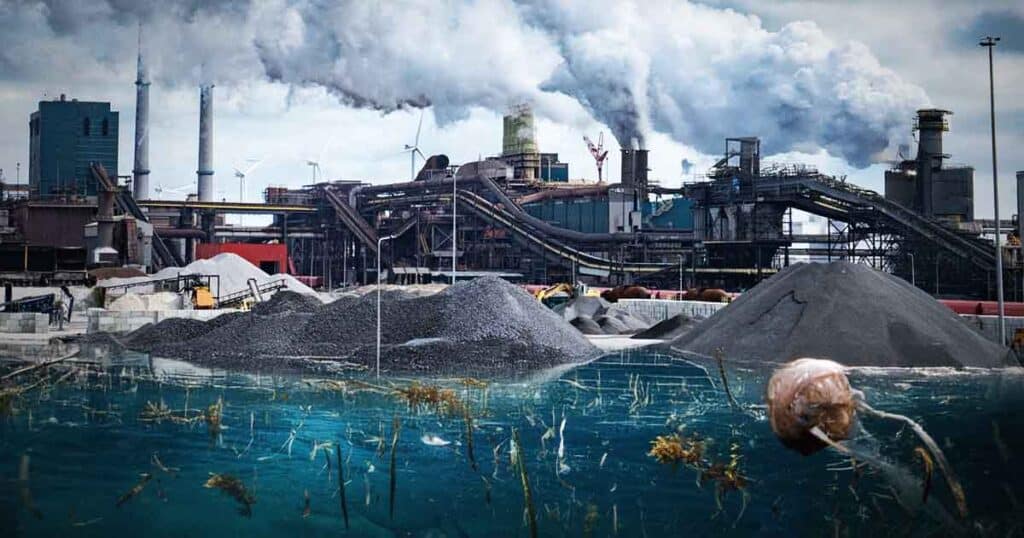A recent global report has highlighted the growing dangers of mercury pollution, particularly from coal-burning power plants, which is now recognized as a major threat to marine ecosystems and public health. While coal remains a primary energy source in many parts of the world, mercury emissions’ environmental and health consequences are often overlooked. This article delves into the report’s alarming findings, exploring the origins of mercury pollution, its widespread effects, and the urgent need for action.

Understanding Mercury Pollution and Its Sources
Mercury, a toxic heavy metal, is released into the atmosphere primarily through the burning of fossil fuels, with coal being one of the largest contributors. When coal is burned in power plants, mercury is released into the air in the form of vapor. This vapor travels long distances before it settles in bodies of water, where it can accumulate in the food chain. Some key sources of mercury pollution include:
- Coal-Burning Power Plants: The largest contributor to atmospheric mercury emissions, especially in countries with high coal consumption.
- Industrial Emissions: Other industries, such as cement manufacturing, also release significant amounts of mercury into the air.
- Waste Disposal: Improper disposal of mercury-containing products such as batteries and thermometers can also add to environmental contamination.
The Dangers of Mercury on Marine Ecosystems
Once mercury settles in oceans, rivers, and lakes, it transforms into methylmercury, a highly toxic compound that accumulates in aquatic organisms. This has several dire consequences for marine life and ecosystems:
1. Bioaccumulation in the Food Chain
- Mercury starts to accumulate in small fish and aquatic organisms. As larger fish eat these smaller creatures, the mercury concentration builds up at higher trophic levels.
- Predatory fish, such as sharks, tuna, and swordfish, accumulate high levels of mercury in their tissues, which can then be consumed by humans.
2. Threats to Biodiversity
- Mercury poisoning has a direct impact on marine biodiversity. It affects the reproductive systems of fish and marine mammals, leading to reduced populations of key species.
- The disruption of the food chain can have cascading effects on entire marine ecosystems, threatening biodiversity and the health of coral reefs, fisheries, and marine flora.
Mercury’s Impact on Public Health
Mercury pollution does not just affect marine life; it poses significant health risks to humans, particularly those who consume seafood regularly. The primary route of mercury exposure in humans is through the consumption of contaminated fish. Some of the key health impacts include:
1. Neurological and Developmental Effects
- Methylmercury is highly toxic to the brain and nervous system. Pregnant women, infants, and young children are especially vulnerable to mercury’s neurotoxic effects, which can result in developmental delays, learning disabilities, and behavioral problems.
- Chronic exposure to mercury can lead to tremors, vision problems, memory loss, and impaired motor function in adults.
2. Cardiovascular Risks
- Studies have shown that long-term exposure to mercury can increase the risk of cardiovascular diseases, including heart attacks and strokes.
- Mercury has been linked to damage to the blood vessels and increased blood pressure, posing a significant risk to public health, particularly in regions with high mercury contamination.
3. Potential for Global Health Crisis
- A recent study indicated that mercury exposure contributes to over 1,000 deaths per year globally, with many cases going unreported due to the slow onset of symptoms and lack of widespread testing for mercury in populations.
Global Response and Policy Measures
1. International Agreements and Regulations
- The Minamata Convention on Mercury, adopted by over 120 countries, aims to reduce mercury emissions and phase out the use of mercury in various industrial processes. The treaty calls for measures to limit mercury emissions from coal-fired power plants and other sources.
- Countries are also encouraged to adopt cleaner technologies, such as renewable energy sources, to replace coal and other mercury-releasing fuels.
2. The Role of Clean Energy
- Transitioning to renewable energy sources such as solar, wind, and hydroelectric power is essential to reduce the reliance on coal and mitigate mercury pollution.
- Many countries are already investing heavily in clean energy infrastructure, though the pace of transition varies by region.
3. Corporate and Industrial Responsibility
- Power companies and industries must implement better pollution control technologies, such as flue-gas desulfurization systems and carbon capture, to reduce mercury emissions.
- Companies must also adopt responsible waste disposal practices, including the proper handling of mercury-containing products.
The Way Forward: Actions and Solutions
To mitigate the global mercury crisis, a multi-faceted approach is required, including:
1. Strengthening Regulations
- Governments must enforce stricter environmental regulations on industries, particularly coal power plants, to reduce mercury emissions. Monitoring systems should be put in place to ensure compliance with emission limits and promote transparency.
2. Raising Public Awareness
- Public education campaigns are critical to raising awareness about the risks of mercury contamination and promoting sustainable seafood consumption practices. Consumers should be informed about which fish species are most likely to be contaminated with mercury.
3. Supporting Research and Innovation
- Investing in research to develop new, mercury-free technologies is essential for reducing the impact of mercury pollution. Innovations in cleaner coal technologies, carbon capture, and energy storage can play a pivotal role in mitigating pollution.
4. Promoting International Collaboration
- The global nature of mercury pollution means that international cooperation is crucial. Countries must work together to share best practices, monitor mercury levels in the atmosphere and oceans, and implement joint strategies to tackle this growing problem.
Conclusion: A Call for Immediate Action
Mercury pollution from coal is a silent yet deadly threat that is already wreaking havoc on marine ecosystems and public health. The global report serves as a stark reminder of the urgency with which this issue must be addressed. Without immediate action to reduce mercury emissions and transition to cleaner energy sources, the environmental and health impacts of mercury will only worsen.
The path forward lies in stronger regulations, international cooperation, and a collective commitment to reducing our reliance on coal and other mercury-emitting industries. It is not only a moral imperative but also a practical one: to ensure a healthier planet for future generations.






